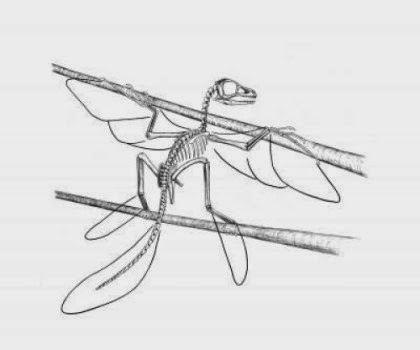
The re-examination of a sparrow-sized fossil from China challenges the commonly held belief that birds evolved from ground-dwelling theropod dinosaurs that gained the ability to fly. The birdlike fossil is actually not a dinosaur, as previously thought, but much rather the remains of a tiny tree-climbing animal that could glide, say American researchers Stephen Czerkas of the Dinosaur Museum in Blanding, Utah, and Alan Feduccia of the University of North Carolina. The study appears in Springer’s Journal of Ornithology.
The fossil of the Scansoriopteryx (which means “climbing wing”) was found in Inner Mongolia, and is part of an ongoing cooperative study with the Chinese Academy of Geological Sciences. It was previously classified as a coelurosaurian theropod dinosaur, from which many experts believe flying dinosaurs and later birds evolved. The research duo used advanced 3D microscopy, high resolution photography and low angle lighting to reveal structures not clearly visible before. These techniques made it possible to interpret the natural contours of the bones. Many ambiguous aspects of the fossil’s pelvis, forelimbs, hind limbs, and tail were confirmed, while it was discovered that it had elongated tendons along its tail vertebrae similar to Velociraptor.
Czerkas and Feduccia say that Scansoriopteryx unequivocally lacks the fundamental structural skeletal features to classify it as a dinosaur. They also believe that dinosaurs are not the primitive ancestors of birds. The Scansoriopteryx should rather be seen as an early bird whose ancestors are to be found among tree-climbing archosaurs that lived in a time well before dinosaurs.
Through their investigations, the researchers found a combination of plesiomorphic or ancestral non-dinosaurian traits along with highly derived features. It has numerous unambiguous birdlike features such as elongated forelimbs, wing and hind limb feathers, wing membranes in front of its elbow, half-moon shaped wrist-like bones, bird-like perching feet, a tail with short anterior vertebrae, and claws that make tree climbing possible. The researchers specifically note the primitive elongated feathers on the forelimbs and hind limbs. This suggests that Scansoriopteryx is a basal or ancestral form of early birds that had mastered the basic aerodynamic maneuvers of parachuting or gliding from trees.
Their findings validate predictions first made in the early 1900’s that the ancestors of birds were small, tree-dwelling archosaurs which enhanced their incipient ability to fly with feathers that enabled them to at least glide. This “trees down” view is in contrast with the “ground up” view embraced by many palaeontologists in recent decades that birds derived from terrestrial theropod dinosaurs.
“The identification of Scansoriopteryx as a non-dinosaurian bird enables a reevaluation in the understanding of the relationship between dinosaurs and birds. Scientists finally have the key to unlock the doors that separate dinosaurs from birds,” explained Czerkas.
Feduccia added, “Instead of regarding birds as deriving from dinosaurs, Scansoriopteryx reinstates the validity of regarding them as a separate class uniquely avian and non-dinosaurian.”
Note : The above story is based on materials provided by Springer.










